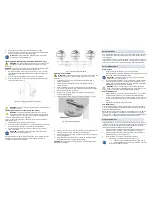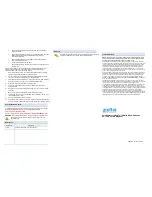
3.
Check that the red LED in the Test button flashes every 32 s.
4.
Press and hold the Test button for 5 s to check the heat alarm audible
warning operates and the red LED flashes rapidly.
WARNING
: The heat alarm has a loud alarm signal. Use hearing
protection when testing heat alarms.
Installing the AC Mains Wiring (AC and AC/DC models only)
WARNING
: To avoid the electrical shock hazard, turn off power to the
area where you plan to install the alarm at the fuse box or circuit
breaker box.
WARNING
: Connect the smoke alarm to a continuous source of mains power.
Ensure the mains power cannot be inadvertently switched off.
1.
Run the mains wiring. Use wiring with conductors of 1 mm
2
~ 2.5 mm
2
cross-sectional area. Wiring should have an insulation resistance of at
least 300 V.
2.
Strip the conductor insulation to expose 5 mm of the conductor
3.
Slide open the terminal cover to access the terminal screws and install
the wiring as shown in Fig. 4.
Fig. 4
– Mains wiring terminals and mounting slots
WARNING
: Take care to ensure the insulation does not get clamped by
the terminal contact.
Installing the Interconnect Function (where fitted)
WARNING
: To avoid the electrical shock hazard, do not use old
wiring that may have been used for mains voltages. Use wiring with
conductors of 1 mm
2
~ 2.5 mm
2
cross-sectional area. Wiring should
have an insulation resistance of at least 300 V.
Up to 11 ZT-Mains-H5 heat alarms can be interconnected, with a maximum
cable length of 150 m.
1.
Install the interconnect wiring as shown in Fig. 5.
2.
Press and hold the Test button for 5 s on each heat alarm, and check the
heat alarm sounder operates on all interconnected heat alarms.
3.
Check that the red LED in the Test button operates only on the heat
alarm being tested.
WARNING
: The heat alarm has a loud alarm signal. Use hearing
protection when testing heat alarms.
NOTE: Heat alarms should be interconnected within only one family residence.
Otherwise, you might encounter nuisance alarms when a heat alarm is
operated or tested in another residence.
Fig. 5
– Interconnect wiring termination
Installing the Heat Alarm
WARNING
: To avoid the electrical shock hazard, turn off power to the
area where you plan to install the alarm at the fuse box or circuit
breaker box.
4.
At the place where you are going to install the heat alarm, draw a
150 mm horizontal line.
5.
Remove the mounting bracket from your heat alarm by rotating it
counter-clockwise.
6.
Place the bracket so that the two longest hole slots are aligned on the
line. In each of keyhole slots, draw a mark to locate the mounting plugs.
7.
Remove the bracket from the ceiling.
8.
Drill two 5 mm (3/16-inch) holes at the marks and insert the plastic
mounting plugs (supplied).
9.
Attach the bracket to the ceiling with the screws supplied (see Fig. 6).
Fig. 6
– Fixing the heat alarm base
10. Align the slot of the bracket with the heat alarm, push the alarm onto the
mounting bracket, and turn it clockwise to lock it into place.
11. Gently pull outward on the alarm to make sure it is securely attached to
the mounting bracket.
12. Press and hold the Test button for 5 s to check the heat alarm audible
warning operates and the red LED flashes rapidly.
WARNING
: The heat alarm has a loud alarm signal. Use hearing protection
when testing heat alarms.
Normal Operation
Once installed and tested, your heat alarm will immediately start monitoring for
heat. If the sounder in the heat alarm operates, check for a fire and execute
your safety plan.
If the alarm was caused by a nuisance situation, open a window or fan the air
to remove the heat from around the heat alarm. The alarm will turn off as soon
as the area is cool. Do not disconnect the battery to silence the heat alarm.
Care and Maintenance
Weekly Tests
1.
Press and hold the Test button for 5 s on each heat alarm.
2.
Check the heat alarm sounder operates with a loud pulsating sound, and
the red LED in the Test button flashes rapidly.
WARNING
: The heat alarm has a loud alarm signal. Use hearing
protection when testing heat alarms.
3.
For interconnected heat alarms, check the heat alarm sounder operates
with a loud pulsating sound on all interconnected heat alarms and the
red LED in the Test button operates only on the heat alarm being tested.
Repeat the test on all interconnected heat alarms.
WARNING
: Never use a naked flame of any kind to test your heat
alarm. You may set fire to and damage the heat alarm, as well as your
home. The built-in Test button accurately tests all alarm functions.
Annual Maintenance
1.
Replace the battery annually with an approved model, or every 10 years
for lithium battery models (see the section User Replaceable Parts).
2.
Vacuum or carefully wipe the cover of the heat alarm to remove any dust,
lint or dirt on the heat alarm cover. Do not spray aerosols into the heat
alarm.
3.
After annual maintenance, test all heat alarms.
Low Battery Alert
When the battery becomes depleted, the heat alarm will signal a short beep
every 32 s. Immediately replace the battery with an approved model (see the
section User Replaceable Parts).
NOTE: Batteries supply a lower voltage in cold conditions, so the Low Battery
signal may start operating late at night. To avoid annoyance, keep a spare
battery on hand, or replace the battery annually before the Low Battery signal
is initiated. The Low Battery signal will operate for at least 30 days.
Protection From Fire
Installing heat alarms is only one step in protecting your family from fires. You
should also reduce the chances that fires will start in your home and you must
increase your chances of escaping safely if one does start. The following
information will help you develop a fire safety program.
1.
Install heat alarms properly. Carefully follow all the instructions in this
manual. Keep your heat alarms clean, and test them every week.
2.
Non-working heat alarms will not alert you. Replace your heat alarms
immediately if they are not working properly.
3.
Follow fire safety rules, and prevent hazardous situations:
Use smoking materials properly. Never smoke in bed.
Keep matches and cigarette lighters away from children.
Store flammable materials in proper containers. Never use
them near open flames or sparks.



